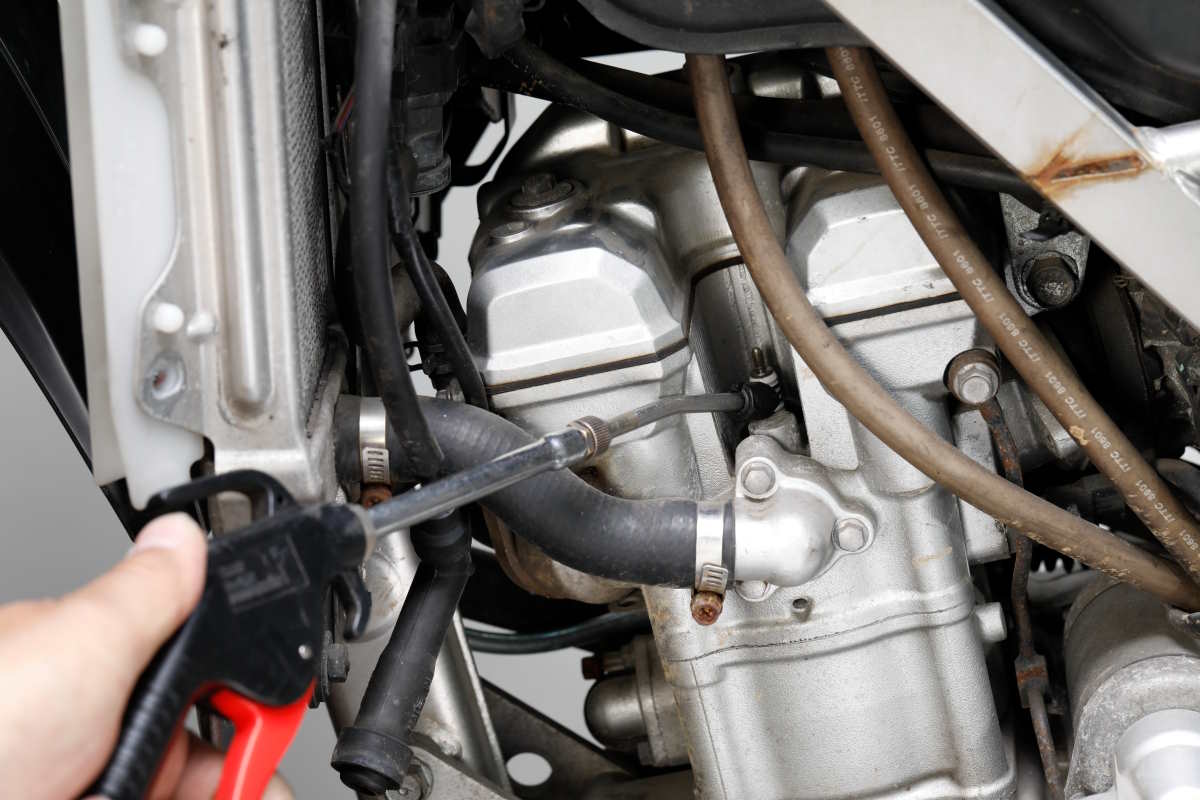Whether the vehicle is carbureted or injected, the spark plug is to be replaced according to the mileage.
Care must be taken not to damage the threads of the cylinder head when installing and removing the plugs, and it is especially important to remove any dirt or grit that has accumulated in the plug hole before removing the plug. If you do not have an air compressor, you can use a bicycle inflator, so make it a habit to always blow a puff of air into the plug before removing it.
- Gravel piled up at the base of the spark plug gets caught on the threads.
- The deeper the engine plug hole, the harder it is for accumulated foreign matter to escape.
Gravel piled up at the base of the spark plug gets caught on the threads.


Carburetor cars have many opportunities to remove and install spark plugs to check carburetor settings, but there are many examples of injection cars that never remove and install spark plugs until it is time to change plugs. The mileage before plug replacement varies depending on the vehicle, but the plug manufacturer’s website indicates 3000 to 5000 km (for NGK general plugs and iridium plugs).
The change to fuel injection for the intake system has eliminated the plugs, and the opportunity to check the condition of burnt plugs has decreased dramatically, as was the case in the carburetor era.
On the contrary, nowadays, in many models, the cowl and gasoline tank must be removed when the plug is to be removed, and the plug is becoming a distant presence psychologically. However, plugs that continue to emit high-voltage sparks in the high-compression combustion chamber need to be replaced periodically because the more distance the plug is driven, the more the electrodes wear out, and the ignition performance declines. This fate is common to both carburetor and injection vehicles.
The most important thing to keep in mind when attaching and detaching the plug is to work on the cylinder head threads so as not to damage them. When installing a plug in a cylinder head, screw the plugin with your finger at first, and use a plug wrench after the threads are firmly engaged because if you use a tool from the beginning, even if the plug is tilted or the threads are clogged with gravel, the tightening torque will be applied, making it difficult to notice anything wrong. This is because it is difficult to notice any abnormality.
The deeper the engine plug hole, the harder it is for accumulated foreign matter to escape.


On this engine, it is easy to see dirt in the plug hole because the sides of the plug are visible, but on multi-cylinder engines with plugs at the bottom of the complete hole, it is not uncommon to not even see where the air is blowing. Remove the plug caps and blow air into them. When there is no more grit or dust, the cleaning is considered complete. If engine oil that has flowed into the cylinder head cover gasket due to poor sealing performance has spewed out, the gasket needs to be replaced.
Air-cooled 2-valve engines and water-cooled 4-valve engines differ in the position and mounting of the spark plug in relation to the cylinder head, and there are various patterns depending on the engine type. In the case of water-cooled 4-valve engines, which are common in sports models, the plug is installed much deeper than the cylinder head cover. This is due to the narrow-angle between the intake and exhaust valves relative to the combustion chamber and the higher position of the camshaft.
In such engines, it is not uncommon to be unable to reach even the tip of the plug without using a plug socket. In such cases, too, over-torque tightening can be prevented by turning the socket or the extension bar connected to the socket with the fingers instead of using a ratchet handle or breaker bar from the start, and abnormalities in the threads can be noticed.
However, care must be taken not only in the process of installing the plug but also when removing it.
In many cases, foreign objects that have accumulated around the plug washers can get caught in the threads. If the plug hole is deep, it is easy for dust and gravel that is rolled up by the tire while driving to get in, and once in, it becomes difficult to pull it out. If the plug is removed in this condition, the dust accumulated at the bottom of the plug hole will enter the combustion chamber through the threads.
If the plug is visible from the outside of the engine, it is easy to check the condition of the washer area. However, when the plug is installed in the second or third cylinder of a four-cylinder engine, which is laid out so that the gasoline tank and air cleaner case cover the cylinder head, it is not uncommon to be groping when inserting the plug socket, and it is not possible to check the bottom of the plug hole. Plug caps with a cover to block the plug hole Models that use plug caps with covers to plug the plug holes are quite advantageous in preventing foreign matter from entering the plug, but they may not be perfect. In addition, engine oil may accumulate in the plug hole due to deterioration of the sealing performance of the cylinder head cover gasket over time.